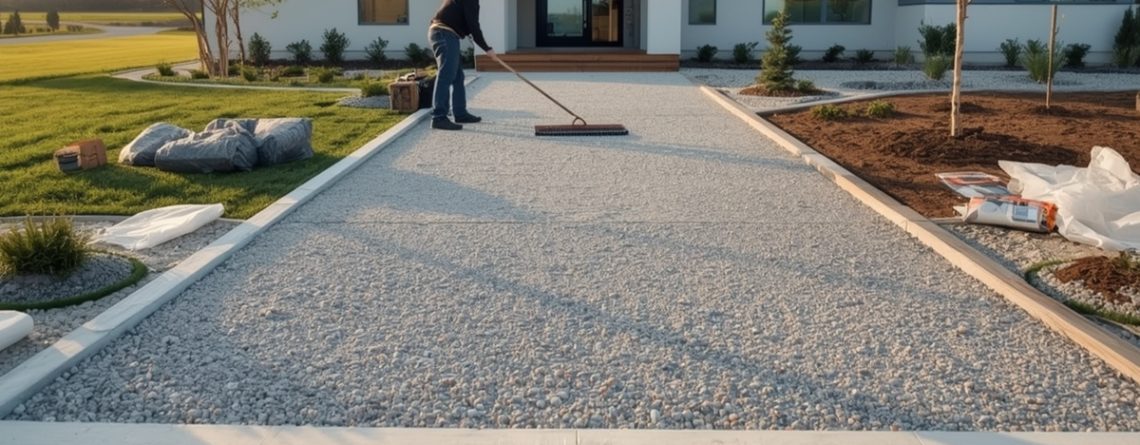14Nov
The Ultimate Guide to Building a Low-Maintenance Gravel Driveway
If you are looking for a practical, cost-effective, and attractive driveway option that does not require constant upkeep, a gravel driveway is an excellent choice. When installed correctly, it can last for decades and blend beautifully with any landscape. The key lies in using the right materials, preparation techniques, and support products, especially for weed control and ground stabilisation.
In this guide, we will walk you through how to build a durable, low-maintenance gravel driveway that looks great all year round.
Why Choose a Gravel Driveway?
Gravel driveways remain popular for good reason. They are:- Affordable: Installation costs are significantly lower than asphalt or concrete.
- Permeable: Rainwater naturally drains through gravel, reducing puddles and runoff.
- Durable: When built with proper support, gravel can handle heavy vehicles with ease.
- Attractive: With many stone colours and textures available, it is easy to match your home’s exterior or garden design.
Planning Your Driveway
Before laying the first stone, spend some time planning. Consider:- Driveway size and layout: Think about how many vehicles you will park and how easily they will manoeuvre.
- Drainage: Gravel allows natural drainage, but if your area is prone to flooding, consider adding a geotextile drainage fabric such as Draintex to prevent waterlogging.
- Edging: A clean edge not only looks good but keeps gravel in place. Steel corten edging or weathering steel garden edging provides a neat, long-lasting border.
- Sub-base stability: A good sub-base prevents ruts and sinking. A gravel grid system like Gravelrings helps lock the gravel in place and provides excellent load support.
Step-by-Step: Building a Low-Maintenance Gravel Driveway
Step 1: Mark and Excavate the Area Mark out the shape of your driveway using string or spray paint. Excavate to a depth of about 200–250mm, depending on your soil type and expected vehicle load. This allows room for the membrane, sub-base, and gravel layers. Step 2: Lay the Driveway Membrane To keep your driveway low-maintenance, install a weed control fabric or geotextile membrane before the sub-base. This stabilises the soil and prevents the sub-base from mixing with the ground below. Growtivation’s Drivetex is a professional-grade stabilisation choice for driveways and roads. It is a heavy-duty non-woven fabric designed specifically for areas under vehicular traffic. Benefits of using Drivetex or similar geotextile fabrics:- Prevents rutting and sinking
- Allows drainage and filtration
- Reduces long-term maintenance
- Provides long-lasting separation between soil and aggregate
- Supports heavy loads, ideal for cars and light commercial vehicles
- Prevents gravel migration and sinkage
- Keeps the surface level and safe
- Allows water permeability for natural drainage
Tips for Long-Term Maintenance
Gravel driveways are naturally low-maintenance, but a little care goes a long way:- Rake occasionally: This keeps the surface even and prevents dips from forming.
- Top up gravel every few years: Add a thin layer to maintain depth and appearance.
- Control weeds: Weed growth should be minimal if you use a quality fabric such as Groundtex, which offers both weed control and stabilisation. Spot-treat any weeds that appear at the edges.
- Keep edges tidy: Sweep away loose stones from nearby walkways or lawns.
- Ensure proper drainage: If puddles form, it may indicate compacted gravel—loosen the surface to restore permeability.
Choosing the Right Materials
The quality of your driveway depends on the materials used. Reputable landscape suppliers such as Landscapes Direct offer durable, proven solutions. Growtivation products available include:- Weedtex: Ideal for light-duty areas such as borders or under decking
- Landtex: A thicker fabric for general landscape use, allowing air and water flow while blocking light to prevent weeds
- Groundtex: Suitable for both soft and hard landscaping projects, offering weed control and stabilisation
- Draintex: Perfect for drainage and filtration beneath driveways and soakaways
- Drivetex: Professional-grade stabilisation choice for driveways and roads

